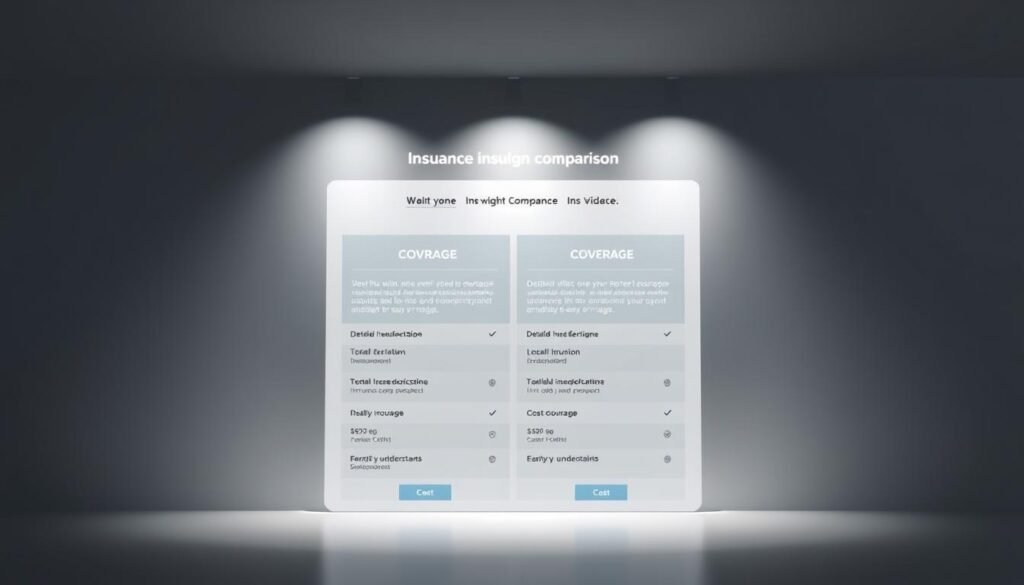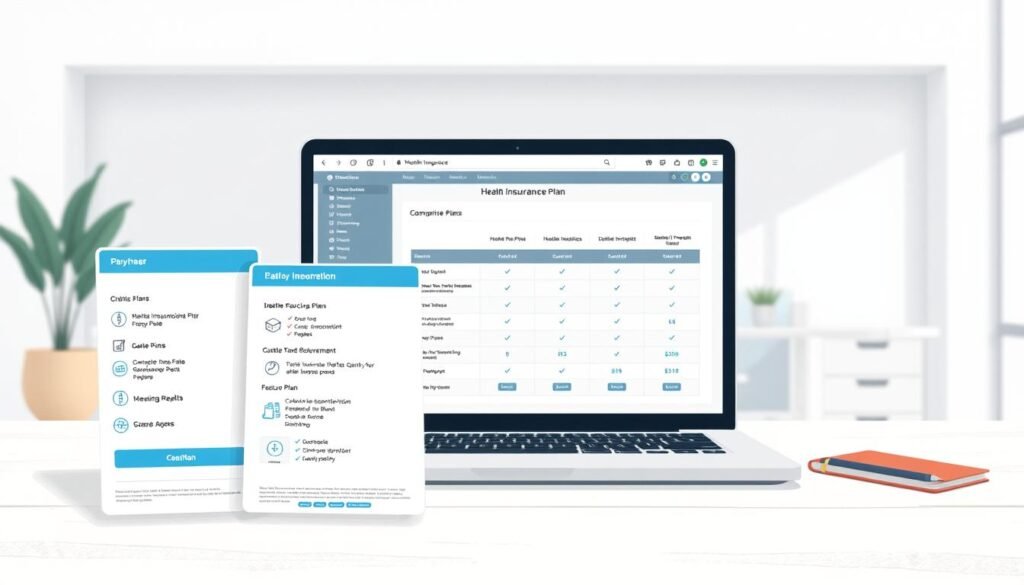Did you know nearly 28% of Americans lack health insurance or have inadequate coverage? With numerous options available, choosing the right insurance plan can be daunting. It’s essential to compare different plans to find the one that meets your needs.
An insurance plan comparison tool can make this task easier. It enables you to assess various plans based on coverage, cost, and provider network. By comparing insurance plans, you can make an informed choice. This ensures you’re well-protected.
Key Takeaways
- Comparing insurance plans helps you find the best coverage for your needs.
- An insurance plan comparison tool simplifies the decision-making process.
- Evaluating plans based on cost, coverage, and network is critical.
- Making an informed decision ensures you’re adequately protected.
- Using a comparison tool can save time and reduce stress.
Understanding Your Insurance Needs
Evaluating your insurance needs is key to making a wise choice when comparing plans. It involves a detailed look at your personal risk factors, life stage, and financial status. This helps determine the right coverage for you.
Assessing Your Personal Risk Factors
Your personal risk factors are vital in figuring out your insurance needs. These include your health, lifestyle, and personal circumstances.
Life Stage Considerations
Each life stage has its own insurance needs. For example, younger people might focus on different coverage types than those nearing retirement.
- Young Adults: May need coverage for education or initial career stages.
- Families: Often require extensive health and life insurance.
- Retirees: Might focus on long-term care and final expense insurance.
Financial Situation Analysis
Your financial situation is also critical in determining your insurance needs. This includes your income, expenses, debts, and savings.
- Assess your current financial obligations.
- Consider your future financial goals.
- Evaluate how different insurance plans can protect your financial stability.
By carefully assessing your personal risk factors, life stage, and financial situation, you can make a more informed decision when comparing insurance plans. This ensures you select a plan that meets your needs and provides adequate protection.
Key Factors to Consider When Comparing Insurance Plans
When comparing insurance plans, it’s important to understand the factors that impact your coverage and financial security. You need to evaluate the elements that will affect your overall insurance experience. This includes various aspects that are critical to your protection.
Coverage Limits and Deductibles
Coverage limits and deductibles are key components to examine. They directly influence the level of protection and out-of-pocket expenses you may incur.
Maximum Coverage Amounts
The maximum coverage amount is the highest amount your insurance provider will pay for a covered loss. Choosing the right maximum coverage amount is essential for your financial protection. For example, when comparing auto insurance rates, a higher maximum coverage amount may increase your premiums but offer greater peace of mind.
Deductible Options and Impact
Deductibles are the amounts you must pay out-of-pocket before your insurance coverage kicks in. Deductible options can significantly impact your insurance premiums and overall costs. A higher deductible may lower your premiums but increase your upfront costs when filing a claim. On the other hand, a lower deductible may result in higher premiums but reduce your out-of-pocket expenses during a claim.

When seeking an affordable insurance plan comparison, finding a balance between coverage limits and deductibles is vital. By carefully evaluating these factors, you can find a plan that meets your needs and budget.
How to Effectively Compare Insurance Plans
With numerous insurance plans available, comparing them effectively is key to finding the right fit. The process involves understanding your insurance needs and evaluating different plans based on various factors.
Using Online Comparison Tools
One of the most efficient ways to compare insurance plans is by using online comparison tools. These tools allow you to evaluate multiple plans side-by-side, making it easier to identify the best option for your needs.
Popular Comparison Websites
Some of the popular comparison websites include those that specialize in insurance comparisons, such as NerdWallet and Policygenius. These websites provide detailed comparisons of various insurance plans, including health, auto, and home insurance.
Interpreting Comparison Results
When interpreting comparison results, it’s essential to look beyond the premium costs. Consider factors such as coverage limits, deductibles, and policy exclusions. By doing so, you can ensure that you’re not only getting the best price but also the coverage that meets your needs.

Using online comparison tools effectively can significantly simplify the process of finding the right insurance plan. By leveraging these tools and understanding how to interpret the results, you can make a more informed decision.
Comparing Health Insurance Options
With numerous health insurance plans available, comparing them effectively is key to making an informed decision. Health insurance plans vary significantly in terms of coverage, cost, and network. Understanding these differences is essential for selecting a plan that best suits your needs.
HMO vs. PPO vs. EPO Plans
Health Maintenance Organization (HMO) plans, Preferred Provider Organization (PPO) plans, and Exclusive Provider Organization (EPO) plans are among the most common types of health insurance plans. HMO plans typically offer lower premiums but have a more restricted network. PPO plans provide more flexibility in choosing healthcare providers but often come with higher premiums. EPO plans fall somewhere in between, balancing cost and network flexibility.
Network Restrictions
One of the primary differences between HMO, PPO, and EPO plans lies in their network restrictions. HMO plans usually require you to receive medical care from providers within the network, except in emergency situations. PPO plans allow you to see any healthcare provider, both in-network and out-of-network, though out-of-network care is more expensive. EPO plans generally do not cover out-of-network care except in emergencies.
Cost Structures
The cost structures of these plans also vary. Premiums, deductibles, copays, and coinsurance are factors to consider. HMO plans often have lower premiums but may have higher copays for certain services. PPO plans have higher premiums but offer more flexibility, potentially reducing out-of-pocket costs if you see out-of-network providers. EPO plans balance premiums and out-of-pocket costs, with a focus on in-network care.

When comparing health insurance options, it’s essential to evaluate both the network restrictions and the cost structures of HMO, PPO, and EPO plans. By doing so, you can identify the best insurance plans comparison that aligns with your healthcare needs and budget.
Compare Auto Insurance Rates and Coverage
It’s vital to compare auto insurance rates and coverage options to make an informed choice. Auto insurance is key for safe driving, protecting you financially against accidents, theft, and unexpected events.
Liability vs. Full Coverage
Choosing between liability and full coverage is a major decision in auto insurance. Liability insurance covers damages to others in an accident, which is often required by law. In contrast, full coverage includes liability insurance plus additional protections for your vehicle against various risks.
Liability insurance is more budget-friendly but doesn’t protect your vehicle. Full coverage offers broader protection but comes with a higher cost.

Factors Affecting Auto Insurance Premiums
Several elements influence auto insurance premiums, making it essential to grasp what affects your rates.
Driving History Impact
Your driving history significantly impacts your insurance premiums. A clean record with no accidents or tickets can result in lower rates. In contrast, a history of claims can increase your premiums.
Vehicle Type and Age Considerations
The type and age of your vehicle also affect your insurance rates. Newer, pricier vehicles typically have higher insurance costs due to higher repair or replacement expenses. Older vehicles, while potentially cheaper to insure, might be more costly to repair if not adequately covered.
By understanding these factors and comparing insurance plans, you can discover an affordable option that suits your needs.
Evaluating Homeowners and Renters Insurance
Understanding the nuances of homeowners and renters insurance is essential for making informed decisions about your coverage needs. Both types of insurance provide financial protection against various risks. They cater to different needs.
Property Coverage Options
Property coverage is a critical component of homeowners and renters insurance. It covers the structure of your home or your personal belongings against damage or loss. This includes damage from fire, theft, or vandalism. When selecting a policy, consider the coverage limits. Ensure they align with the value of your property or belongings. Adequate coverage can help you recover more quickly from a loss.
Liability Protection
Liability protection is another vital aspect of homeowners and renters insurance. It shields you against financial loss if someone is injured on your property. It also covers accidental damage to someone else’s property. This coverage can help pay for legal fees and damages. Using an insurance plan comparison tool can help you find a policy that offers sufficient liability protection.
Natural Disaster Coverage Considerations
Natural disasters like floods, earthquakes, and hurricanes can cause significant damage to your property. Standard homeowners and renters insurance policies may not cover all types of natural disasters. Flood insurance and earthquake protection often require separate policies or endorsements.
Flood Insurance Requirements
If you live in a flood-prone area, you may be required to purchase flood insurance. This coverage can be obtained through the National Flood Insurance Program (NFIP) or private insurers.
Earthquake Protection
For those living in earthquake-prone regions, earthquake insurance can provide critical coverage. This insurance can help cover repair costs or replacement of your home and belongings damaged during an earthquake.
By carefully evaluating your homeowners or renters insurance options and using the best insurance policy comparisons available, you can make an informed decision. This decision will protect your financial well-being.
Life Insurance Plan Comparison Strategies
Effectively comparing life insurance plans requires grasping the various policy types. Life insurance acts as a financial safeguard for your family in case of your death. It’s essential to compare different plans to make a well-informed choice.
Term vs. Whole Life Insurance
Term and whole life insurance are the two main types. Term life insurance offers coverage for a set period, usually between 10 to 30 years. It pays a death benefit if you die within the term but doesn’t build cash value. In contrast, whole life insurance covers you for life and grows a cash value over time.
Cost Comparison
Cost is a key factor when comparing term and whole life insurance. Term life is generally cheaper, more so for younger people. Yet, whole life premiums stay the same, while term life premiums rise with age or policy renewal.
Investment Components
Whole life insurance often includes an investment aspect, allowing premiums to grow as cash value. This cash can be borrowed or used for premiums. Term life, lacking this investment feature, is simpler and more affordable for many.
| Feature | Term Life Insurance | Whole Life Insurance |
|---|---|---|
| Coverage Period | Specified term (e.g., 10, 20, 30 years) | Lifetime coverage |
| Premiums | Generally lower, increases with age or renewal | Level premiums throughout life |
| Cash Value | No cash value accumulation | Accumulates cash value over time |
Understanding the differences between term and whole life insurance aids in making a better choice. Reflect on your financial objectives, budget, and coverage needs to select the most suitable plan.
Specialized Insurance Plans Worth Considering
There are specialized insurance options beyond the standard ones. These plans offer additional protection for specific needs not covered by general policies.
Disability Insurance
Disability insurance is vital for those who depend on their income. It ensures financial security if an unexpected disability prevents work. Recent top insurance plan reviews highlight its importance in a complete insurance portfolio.
Long-Term Care Insurance
Long-term care insurance covers costs for care like nursing homes and home health. It’s key to check if long-term care is included in health insurance or if a separate policy is needed.
Umbrella Policies
Umbrella policies offer extra liability coverage beyond standard policies. They act as a safety net for unexpected events or lawsuits. Insurance experts suggest they are wise for those with significant assets to protect.
In summary, plans like disability, long-term care, and umbrella insurance offer critical protection. Reviewing these options is essential for a well-rounded insurance strategy.
Common Mistakes to Avoid When Comparing Insurance Plans
To make an informed decision, it’s essential to steer clear of common errors when comparing insurance plans. A well-informed comparison can help you secure the best insurance policy that meets your needs.
Focusing Only on Premium Costs
One of the most significant mistakes is focusing solely on premium costs. While affordability is key, it’s equally important to consider the coverage and benefits offered by the insurance plan. Cheaper plans may not provide adequate coverage, leaving you vulnerable in the event of a claim.
For instance, a plan with lower premiums might have higher deductibles or limited coverage, ultimately costing you more in the long run.
Overlooking Policy Exclusions
Another critical mistake is overlooking policy exclusions. It’s vital to understand what’s not covered by your insurance plan to avoid surprises when filing a claim. Carefully review the policy exclusions to ensure you’re not caught off guard.
Underestimating Coverage Needs
Underestimating your coverage needs can lead to insufficient protection. Assess your personal risk factors and financial situation to determine the right level of coverage. Consider factors like income, assets, and dependents when evaluating your insurance needs.
| Common Mistakes | Consequences | Best Practices |
|---|---|---|
| Focusing only on premium costs | Inadequate coverage | Consider coverage and benefits |
| Overlooking policy exclusions | Surprises when filing a claim | Carefully review policy exclusions |
| Underestimating coverage needs | Insufficient protection | Assess personal risk factors and financial situation |
Conclusion: Making Your Final Insurance Decision
Understanding insurance is complex, yet essential. This article has covered vital aspects to consider when comparing insurance plans. We’ve looked at personal risk factors and various insurance coverage types.
Comparing insurance plans is more than finding the cheapest option. It’s about balancing cost and coverage. An insurance plan comparison tool helps you evaluate plans and make a well-informed choice.
The table below outlines key considerations for comparing insurance plans:
| Insurance Type | Key Considerations |
|---|---|
| Health Insurance | Coverage limits, deductibles, HMO vs. PPO vs. EPO plans |
| Auto Insurance | Liability vs. full coverage, factors affecting premiums |
| Life Insurance | Term vs. whole life insurance, coverage amounts |
Evaluating these factors and using the right tools is key. Your goal is to find a plan that offers enough coverage at a fair price.
In conclusion, comparing insurance plans is vital for your financial security. Follow the guidelines in this article and use an insurance plan comparison tool. This way, you can make an informed choice and select the best insurance plan for your needs.
Sources
For more details on comparing insurance plans and making informed decisions, check out these resources:
- Consumer Reports: Insurance Guides
- NerdWallet: Comparing Insurance Rates
- Insure.com: Compare Insurance Quotes
- Policygenius: Insurance Comparison
These sources offer valuable insights and tools. They help you navigate the complex world of insurance. This way, you can make the best choice for your needs.
FAQ
What are the key factors to consider when comparing insurance plans?
When comparing insurance plans, it’s vital to look at coverage limits, deductibles, and their impact on your overall protection. Your personal risk factors, life stage, and financial situation are key to finding the right coverage. This ensures you’re adequately protected.
How can I effectively compare health insurance options?
To compare health insurance, understand the differences between HMO, PPO, and EPO plans. Consider network restrictions and cost structures. Online tools can help you evaluate these options, guiding you to the best choice for your health needs.
What is the difference between liability and full coverage auto insurance?
Liability auto insurance covers damages to others in an accident. Full coverage, on the other hand, includes liability, collision, and comprehsensive coverage. It offers broader protection. Your driving history and vehicle type can influence your premiums.
How do I choose the right life insurance plan?
Choosing life insurance involves weighing term vs. whole life, comparing costs, and considering investment aspects. Your financial situation and goals are critical in selecting the right plan for you.
What are some specialized insurance plans worth considering?
Consider disability, long-term care, and umbrella policies for specialized coverage. These plans address specific risks and can be customized to fit your needs.
What are common mistakes to avoid when comparing insurance plans?
Avoid focusing only on premium costs and overlooking policy exclusions. Also, don’t underestimate your coverage needs. Thoroughly reviewing and comparing plans ensures you make an informed choice.
How can I compare insurance plans online?
Use online tools and websites to compare insurance plans. These resources allow you to evaluate health, auto, and life insurance options. They help you make decisions based on your needs and budget.
What should I consider when evaluating homeowners and renters insurance?
When evaluating insurance, consider property coverage, liability protection, and natural disaster coverage. Assess your specific needs and risks to choose the right coverage for you.
